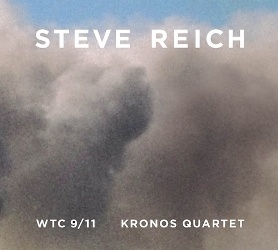Steve Reich – WTC 911 (2011)
Steve Reich – WTC 911 (2011)

1. WTC 9/11: I 9/11; 2. WTC 9/11: II 2010; 3. WTC 9/11: III WTC; play 4. Mallet Quartet: I Fast; 5. Mallet Quartet: II Slow; 6. Mallet Quartet: III Fast; 7. Dance Patterns Performer: WTC 9/11 (2010): Kronos Quartet (David Harrington, violin; John Sherba, violin; Hank Dutt, viola; Jeffrey Zeigler, cello). Mallet Quartet (2009): Sō Percussion (Eric Beach, Jason Treuting, vibraphone; Josh Quillen, Adam Sliwinski, marimba). Dance Patterns (2002): James Preiss, Thad Wheeler, vibraphone; Frank Cassara, Garry Kvistad, xylophone; Edmund Niemann, Nurit Tilles, piano.
The first performance of WTC 9/11, Steve Reich's memorial to September 11, took place at Duke University-- 500 miles south of Ground Zero. From there, it traveled to L.A.-- nearly 3,000 miles west of the attacks it commemorated-- before touching down in Carnegie Hall a month later. It was an oddly circuitous cross-country tiptoe for a work by a native New Yorker about the collapse of the towers he lived four blocks from, but it spoke to the fearsome difficulty in addressing 9/11 headlong. There is still, 10 years later, an instinctive flinch mechanism built into our communal central nervous system surrounding the day, and it presents a forbidding hurdle for artists attempting to speak to it.
Reich, as unofficial American composer laureate and a quintessentially New York City figure, would seem more outwardly qualified than most, which only makes his failure all the more disheartening. WTC 9/11 takes the same form as Reich's Different Trains, another piece that treated an atrocity-- in that instance, the trains transporting Jews to concentration camps-- with a sorrowful Zen gaze. Like Trains, WTC pairs the Kronos Quartet with manipulated recorded voices, the strings accompanying the recordings to draw out the anxious unheard music in their intonation and rhythm. It's a spectacular compositional technique, bridging the invisible gap where words become music.
Within minutes, however, WTC 9/11 rams up against an unavoidable problem: These raw materials are, well, simply too raw. The voices Reich highlights in his music are a mix emergency dispatches from 9/11 and interviews conducted in 2010 with his close friends. Much of what they say is nearly unbearable to hear, even a decade on. If there is a way to subsume a 9/11 survivor saying, "Three thousand people were murdered. What's gonna happen here next?" into a larger musical work, Reich didn't find it. The words burn through the music's fabric like tissue paper, leaving you jarred but neither enlightened nor transformed.
The smaller moments in the piece, painting the texture of daily life on the morning of the attacks, ring true with tension and foreboding. The conversational, lilting swing of "I was sitting in class. Four blocks north of Ground Zero", for instance. A sobbing cello catches the falling note of plaint in the phrase "Nobody knew what to do." At the intonation of "We all thought it was an accident" (spoken by Reich’s friend and colleague, Bang on a Can co-founder David Lang), the strings allow a brief glint of a major key to peak in, a moment of fugitive hope. Unfortunately, the moments that freeze you in place -- lines like "debris engulfed everybody that was there," or a desperate shout of "I'm trapped in the rubble"-- owe nothing at all to Reich's music; indeed, they all but erase your awareness of the music around them.
The Nonesuch recording of WTC 9/11 is rounded out by other recent-vintage Reich pieces, and to spend time in their company after the heightened, jagged WTC is a relief. His 2009 Mallet Quartet is a delicate and ringing interlocking of marimbas that feels as cleansing as spring rain, while Dance Patterns, for a battery of vibraphones, xylophones, and pianos, plays like a glistening, fond medley of Reichisms. The framework of Reich's pieces feels well-worn by now-- his "fast-slow-fast" structure now has a "loud-quiet-loud," "verse-chorus-verse" inevitability to it. The shifts in key midway through movements feel less like the blooming of an unexpected thought now than slides in a ViewMaster clicking duly into place. You smile and nod knowingly, but the goosebumps are gone. --- Jayson Greene, pitchfork.com
Muzyka Steve'a Reicha - Nowojorczyka, jednego z najważniejszych współcześnie kompozytorów - napisana z okazji 10 rocznicy ataku na Amerykę jest swoistą, subiektywną, prywatną wręcz, kroniką tych wydarzeń, powstałą z kolażu słów nocznych świadków i muzyki Kronos Quartet, z którymi Reich współpracuje już przeszło 20 lat. Choć "dokumentalny" pomysł na tę kompozycję wydaje się dość prosty, nie zmienia to faktu, że podczas słuchania trudno pozostać na tę muzykę niewzruszonym.
Kompozycja Reicha składa się z trzech części – pierwsza to zapis dźwięków z czasu ataku - głosy kontrolerów lotu, raportujących katastrofę. Druga to komentarze pracowników służb ratunkowych, dzielących się swoimi wspomnieniami z perspektywy czasu. „Drugi samolot przeleciał nad naszymi głowami”, „Myślałem, że to wypadek”, „Wszyscy biegali”, „Ludzie skakali z budynków”. „Chaos”. Trzecia część to wspomnienia sąsiadów Reicha, opowiadających o tym, co działo się w pierwszych kilku, kilkudziesięciu godzinach po ataku. „Ciała zostały przeniesione do namiotów na wschodnim Manhattanie”. „Całą noc śpiewaliśmy piosenki”. „Po prostu siedziałem” i próba konstrukcji wizji tego, co będzie dalej, pozostająca bez odpowiedzi – „and there's a world right here”.
Muzyka Kronos Quartet podąża za nagranymi głosami, śledzi ich muzyczność, naśladując melodię nagranych wypowiedzi świadków. WTC 9/11 to kompozycja-słuchowisko, memento – właściwie sprowadzone do najprostszej, najczystszej muzycznie postaci.
Album WTC 9/11 dopełniają dwie wcześniejsze kompozycje Reicha - Mallet Quartet wykonane przez Sō Percussion na 2 wibrafony i 2 marimby (do kompaktowego wydania tego albumu dołączone będzie DVD z wykonaniem tego utworu) oraz Dance Patterns, powstałe pierwotnie jako muzyka do filmu Counterphrases of Anne Terese de Keersmaeker’s Choreography rozpisnana na ksylofon, wibrafon i fortepian. --- Kajetan Prochyra, jazzarium.pl
download: uploaded yandex 4shared mediafire solidfiles mega filecloudio nornar ziddu
Last Updated (Thursday, 03 April 2014 09:06)








